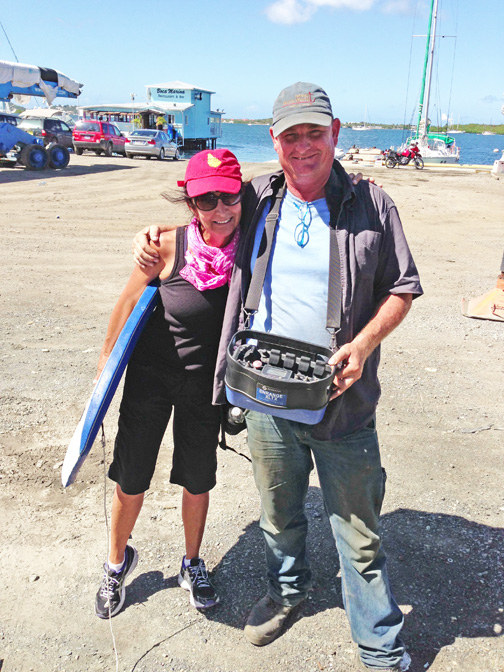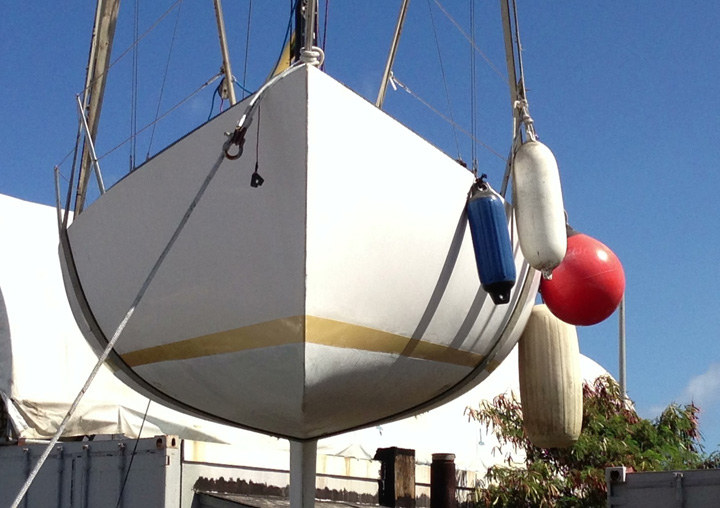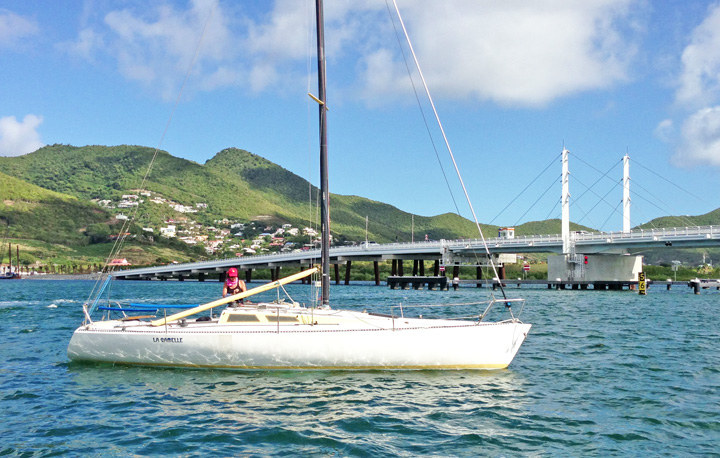
Caribbean Dispatch #3
In Wednesday’s CB #2, we reported on how we discovered that rats/mice had gotten aboard the Wanderer’s Olson 30 La Gamelle and started feasting on candle wax, tampons, boogie boards, mayonnaise, a North Gatorback main, and other goodies. In the case of the mainsail, the joke was on them, however, as the ancient main — without reef points! — was headed for the trash anyway.

©2014 Latitude 38 Media, LLC
We’re sure the rats/mice had no trouble getting up onto the boat because her hurricane tie-downs were webbing, which is like a ladder for rodents. Later we learned that the immediate area our boat was in hadn’t been anything like it a few months before.

©2014 Latitude 38 Media, LLC
"When we got here in October, there were weeds as high as the toerail of your boat," laughed former San Francisco restaurateur Juliano Darbe, who hauled his Challenger 40 Serenity at the St. Martin Shipyard about when we did in May. Rats, weeds, it didn’t really make any difference to us, as neither did any damage.
However, La Gamelle did have water up to the floorboards — there is no keeping all the water out during the torrential squalls of summer — and because of the humidity, a lot of mold. We’re going to have to put out some bowls of Clorox to take care of that. Or better yet, hire someone to clean it up.

©2014 Latitude 38 Media, LLC
The St. Martin Shipyard couldn’t be much more than 300 feet from the runway at the Princess Juliana Airport in St. Martin, where 747s are notorious for jet-washing beachgoers into Maho Bay. (Google it and get a giggle.) As a result, all the boats in the shipyard — even La Gamelle, easily the smallest — had to have red flags hoisted to their mastheads. It seemed a little silly to us, as no pilot was going to be able to see a red flag at night, and the mast on La Gamelle, being half the height of those on many nearby boats, wasn’t going to be much of a threat to a 747 that had already missed the runway by 300 feet. But we don’t know anything about aviation.
The St. Martin Shipyard is a bit of a mess as shipyards go. The hardstand is dirt and there is junk all around. But they haul some pretty impressive boats, in particular larger catamarans. They were doing a lot of work on hull #2 of the Sunreef 80 cats that are built in Poland. We can assure you that an 80-foot cat is almost unfathomably larger than a 63-ft cat such as Latitude’s Profligate. Hank, the very likable Dutch manager of the shipyard, told us that when he went aboard, he saw that the bilges are over six feet deep. In other words, if the average American stood on the inside of the bottom of the hull, the floorboards would be over his head!
Hank told us that the original Sunreef had been built too heavy, so they ended up building #2 too light. As a result, the bow was way out of the water, causing all kinds of problems. The first attempt at a solution was to put 10,000 pounds of weight in the bows. On a catamaran! That didn’t work, so there was a small army of workers doing all kinds of nasty work on that monster of a boat. However, it didn’t mean the German owner couldn’t go sailing, as he also owns the nearby dark blue-hulled Lagoon 67, which was also hauled out. She’s for sale.
The shipyard uses a monster-size radio/controlled Sea Lift to haul the boats out and put them back in the water. This contraption — the much bigger brother of the one used to launch ‘ti Profligate in the British Virgins — is about 120 feet long and about 20 feet high. The employees park their cars beneath it to protect them from the tropical sun. The Sea Lift is that big.
Displacing a mere 3,000 pounds, all La Gamelle needed to be dropped in the water was a fork lift, as is commonly used in California. Alas, the only smaller thing the Shipyard had than the Sea Lift was a crane that was as tall and powerful as it was old. It may have been the first one ever made.
Anyway, the West Indian crew undid the tie-downs, put on the straps, and up in the air she went. La Gamelle was the model of diversity, as no two of her fenders were alike. She had a big round orange one, a white one big enough for a 100-footer, a small white one, and a bright blue one. We were so proud.
People aren’t so uptight in the Caribbean, so when we asked Hank if de Mallorca could climb aboard the crane for a staged photo op with the boat in the air, he said sure, as if it were the most natural request in the world. We were going to ask him to let her lower the boat into the water, but we figured we’d save that for next time.
As soon as La Gamelle was floating, the West Indian crew advised us to hop aboard and check for leaks.
"Don’t need to," we said.
"Why not?"
"She doesn’t have any thru-hulls."
They looked at us as though we were speaking a patois they didn’t understand.
Since La Gamelle doesn’t have an engine, de Mallorca took the helm, and we got into the 12-ft Carib and started pushing the transom. This is 10 times more effective than trying to tow the Olson with a dinghy. And an Olson doesn’t need much of a push to get moving.
There were two hurdles, if you will, to getting La Gamelle out to Simpson Bay and tied up behind ‘ti Profligate, her mothership. The first was the new Causeway Bridge that cuts across Simpson Lagoon. To our eyes it’s a hideous structure that mars the natural beauty of St. Martin. At night it’s even worse, because it lights up and changes colors like those massive pylons at the entrance to LAX. Most locals seem to be proud of it, despite the fact that it apparently hasn’t alleviated traffic much at all.
The Causeway Bridge consists of two long ramps, then an island in the center, on which a bridge section rotates, allowing boats to pass at selected times during the day. Although new, it seems to be having as many problems at the new East Bay span. "And it’s not a Caribbean job," said Hank with a jolly laugh, "we Dutch designed and built it." If you live and work in the Caribbean, you get used to nothing working as it should.
Anyway, the Causeway Bridge worked as it should, so shortly before 4 p.m., we were on the Dutch side of Simpson Bay, waiting for the lift bridge to open so we could head out into the Caribbean Sea. The 4 p.m. bridge opening is a popular tourist attraction that packs the nearby St. Martin YC to the gills, as it usually features at least several megayachts squeezing out the narrow opening. Even after Leslie Wexner — he of Victoria’s Secret and other women’s clothing endeavors — paid a lot of money to have the opening made bigger so his 235-ft Unlimited could pass through, skippers have still had trouble. The banged up timbers and cement walls on the side of the opening are testament to botched transits
Anyway, all the boats made it out fine, including gallant little La Gamelle. Yet the next day this would be the scene of one of the biggest frights of our lives. More on that in the next Caribbean Dispatch.
